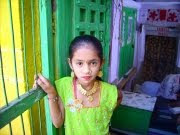 Mon histoire sur les rickshaw-vélos, cette fois-ci dans sa version pour Tehelka.
Mon histoire sur les rickshaw-vélos, cette fois-ci dans sa version pour Tehelka.A new generation of cycle rickshaws has come. With their innovative design, they will definitely conquer the heart of environment-conscious commuters, says ADELINE BERTIN.
A revolution is underway in the crowded streets of dusty Delhi. While the trendy and expensive four-wheelers block the arterial streets, lighter and faster cycle rickshaws are progressively making their way in the north campus of Delhi University.
Larger, with longer roofs and wheels decorated with flashy little gadgets, they immediately catch the eyes of the passerby. Along with the hordes of other ordinary cycle-rickshaws, they wait patiently outside the Vishwa Vidyalaya metro station exit, while passengers surface regularly to dive into the sweltering heat of the city.
The new-age cycle rickshaws were created recently by twenty-five students from the Sri Ram College of Commerce (SRCC), members of the international organisation Students in Free Enterprise (SIFE). On a mission to ensure that the rickshaw-wallahs get their own vehicle, they are helped by jovial faculty advisor Abhay Kumar, who explains the origin of the project: “We wanted to help marginalised people. After a round of discussion with the students last summer, we finally agreed to help rickshaw-wallahs, who have very poor living conditions.”
A majority of them are illiterate and at the mercy of vehicle owners, they hire rickshaws everyday for Rs 50. If the drivers come back without the money in the evening, they are systematically beaten, without any mercy. “The best way for us was to help them get their own rickshaw, by taking out a bank loan. At first, nobody wanted to help us, but eventually, the Punjab National Bank (PNB) accepted to collaborate.”
Meanwhile, a new design was created by the students, which provides very competitive assets to the vehicle. For the driver, a longer roof to protect from sun, dust or rain, two small rear-view mirrors and an overall lighter rickshaw. For the passengers, more comfortable seats, an extended open space under the roof and two newspapers. The final touch, a little red dustbin, introduces the revolutionary concept of a cycle rickshaw certified 100% eco-friendly. Its cost: Rs 8,000, instead of Rs 7,500 for the normal rickshaw.
Five rickshaw-wallahs got their vehicle on December 17 last year, in the presence of Sheila Dikshit, Chief Minister of Delhi. They now earn a lot more, approximately Rs 300 per day. They confess with a large smile that they are very happy and satisfied. “I have more customers now, who call me on my mobile phone if they need a ride, like the taxis,” says Ram Shiromani, rickshaw-wallah since five years, proudly wearing his new navy blue uniform. He adds, more seriously: “I bought some gifts for my family, but it was a rare occasion. I usually save the money on my own bank account.”
Siddhartha Jain, co-president of SRCC-SIFE, describes the role of the students in the project: “Our aim is to provide the rickshaw pullers with an appropriate training and a basic knowledge of their job, for them to become responsible and independent in the future. For instance, we explain to them what a bank loan is, and teach them the traffic rules. In addition to this, they learn how to speak proper English, as well as how to behave decently with clients.”
Five more lucky drivers got their own vehicles one week ago, while more than twenty are still waiting to become owners themselves in May and June. Now the challenge is to provide the new-age vehicles to the rickshaw-wallahs working in DU before the beginning of the Commonwealth Games in October, to fulfil the wish of Sheila Dikshit.

